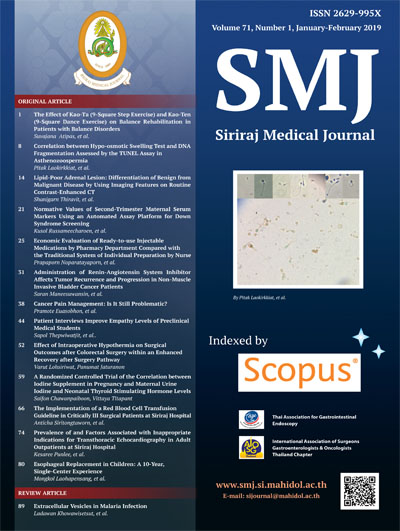Normative Values of Second-Trimester Maternal Serum Markers Using an Automated Assay Platform for Down Syndrome Screening
DOI:
https://doi.org/10.33192/Smj.2019.04Keywords:
Automated immunoassay; Down syndrome; maternal serum screening; quadruple test; reference values; second trimesterAbstract
Objective: Automated chemiluminescent immunoassay has several advantages over manual ELISA with comparable
test performance. Few studies have reported the reference values of the second-trimester serum markers maternal
serum alpha-fetoprotein (AFP), human chorionic gonadotropin (hCG), unconjugated estriol (uE3), and inhibin
A (Inh A) by automated immunoassay in Asian population. Accordingly, this study aimed to determine the
median values of second trimester serum markers as a function of gestational age (GA) in Thai population using
an automated immunoassay.
Methods: This prospective cross-sectional study of serum markers in healthy singleton second trimester (14-22
weeks) pregnant women was conducted at Siriraj Hospital from September 2012 to April 2015. Maternal serum
AFP, hCG, uE3, and Inh A were analyzed by automated immunoassay. Predicted median values as a function of
GA were calculated from best-fit regression equations.
Results: A total of 1,526 women were included. Median values serum markers were constructed from the following
optimal models: AFP (ng/mL) = 99.082 - 14.195 GA + 0.662 GA2, r2=0.995; hCG (mIU/mL) = 390168.106 - 35
968.397GA + 876.708GA2, r2=0.972; uE3 (ng/mL) = -3.388 + 0.274 GA, r2=0.997; and, Inh-A (pg/mL) = 1206.875 -
114.171 GA + 3.174 GA2, r2=0.882. Using the same platform analysis and maternal weight adjustment, the reference
values in Thai population were shown to be different from those of other ethnicities.
Conclusion: Median values of second-trimester serum markers for Thai population were determined. Maternal
weight and the use of population-specific normal values have to be taken into account for Down syndrome screening
in the second trimester.
Downloads
Published
How to Cite
Issue
Section
License
Authors who publish with this journal agree to the following conditions:
Copyright Transfer
In submitting a manuscript, the authors acknowledge that the work will become the copyrighted property of Siriraj Medical Journal upon publication.
License
Articles are licensed under a Creative Commons Attribution-NonCommercial-NoDerivatives 4.0 International License (CC BY-NC-ND 4.0). This license allows for the sharing of the work for non-commercial purposes with proper attribution to the authors and the journal. However, it does not permit modifications or the creation of derivative works.
Sharing and Access
Authors are encouraged to share their article on their personal or institutional websites and through other non-commercial platforms. Doing so can increase readership and citations.















